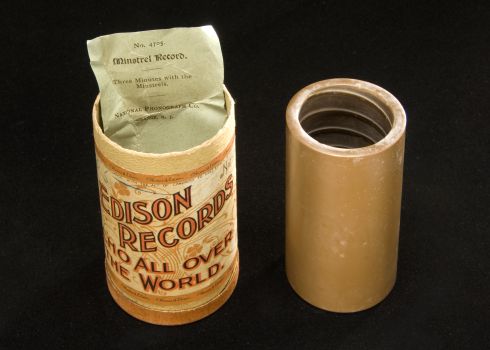Brown Wax Cylinders (1895–1901)

Brown wax cylinders were the first sound recordings produced on a widespread commercial scale. Physically, these recordings are closest to the commonly understood idea of "wax"—that is, something waxy in a tactile sense, like a candle. In fact, the earliest cylinders, the so-called "white wax" cylinders, were originally derived from a blend of plant and animal waxes. The variability of the wax quality from these sources, however, caused Edison to abandon them in favor of a standardized metallic soap composite, which created a cylinder that felt waxy, even if it wasn't technically a wax.
During their heyday at the turn of the 20th century, brown wax cylinders were sold with an accompanying slip of paper to identify the recording. Since only a release number was inscribed on the circumference of most cylinders, the paper was the sole visual evidence of the contents of the recording. Most of these original slips have been lost, so determining exactly what is on a given brown wax cylinder can be challenging. Fortunately, virtually all of the commercial brown wax cylinders contained spoken introductions identifying at least the song title and performer. Factors inhibiting identification of these cylinders include their unfortunate tendency to develop mold growth and the variable rate at which these early cylinders were recorded—ranging generally between 120 and 160 RPM.
Besides the commercially released brown wax cylinders, the UCSB collection also contains a small series of home recordings. These cylinders were made from wax "blanks," which Edison claimed could be reused up to 100 times by literally shaving off the old grooves. In this way, brown wax blanks could perhaps be considered an early rewritable medium, akin to a CD-RW today. For these home recordings, discerning identification information as well as playback speed is often impossible. Yet hearing them can be a fascinating, even otherworldly experience: a crying baby who cannot be pacified, say, or a drunken caterwauler flailing through a song, their identities forever lost to time.

